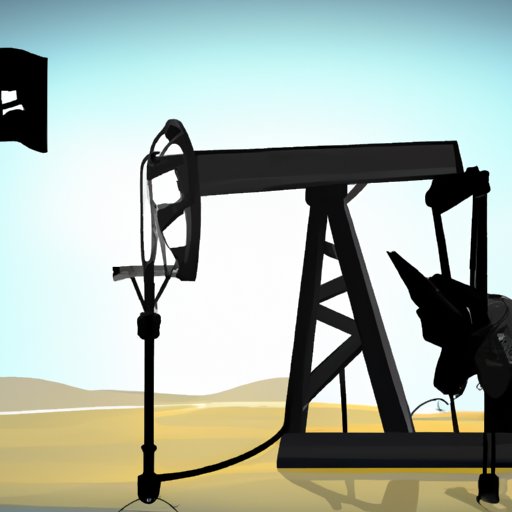Introduction
Oil is one of the most important commodities in the world today, with its production and consumption having a significant impact on the global economy. The demand for oil continues to grow and it is estimated that by 2040, global oil consumption will reach over 100 million barrels per day. As such, understanding which countries produce the most oil and how they influence the global market is essential.
Exploring the Top Oil-Producing Countries in the World
In 2019, the top three oil producing countries in the world were the United States, Saudi Arabia, and Russia. These countries accounted for more than 40% of the total global oil production. The US had the highest output, followed by Saudi Arabia and then Russia. Other major producers include China, Canada, and Iran.
It is important to note that the output of individual countries can vary significantly from year to year. For example, in 2018, Russia was the second-largest producer behind the US, while Saudi Arabia was third. However, in 2019, Saudi Arabia overtook Russia to become the second largest producer.
When comparing different countries’ output, it is important to consider the size of their reserves. For example, Saudi Arabia has much larger reserves than Russia, meaning that it can produce more oil. On the other hand, Russia has much smaller reserves, but it is still able to produce significant amounts of oil due to its efficient extraction methods.
In addition to size of reserves, there are several other factors that can influence a country’s oil production. These include political instability, economic conditions, and technological advancements.
A Comprehensive Overview of Global Oil Production
Global oil production has increased steadily over the past decade, reaching an all-time high of 99.2 million barrels per day in 2019. This represents an increase of 7.3% since 2010. The US is the largest producer of oil, accounting for almost 19% of the total global output.
The majority of the world’s oil is produced from conventional sources, such as oil wells. This type of production involves drilling into the ground and extracting crude oil. Unconventional sources, such as shale oil, are becoming increasingly important and account for around 10% of global production.
Oil production has a significant effect on the global economy. It provides jobs for millions of people, generates billions of dollars in revenue for governments, and helps to fuel economic growth. In addition, it plays an important role in energy security, as it is used to power cars, ships, planes, and other vehicles.
Examining the Role of Oil in the Global Economy
The Organization of the Petroleum Exporting Countries (OPEC) is an intergovernmental organization that regulates the supply of oil and sets the price of oil. Its members account for more than 40% of the world’s oil production and over 80% of the world’s proven oil reserves.
OPEC works to balance supply and demand in order to ensure stable prices. When demand is low, OPEC reduces production to prop up prices. Conversely, when demand is high, OPEC increases production to prevent prices from rising too quickly.
The price of oil can have a significant impact on the global economy. High prices can lead to inflation, while low prices can lead to deflation. They can also have a major effect on the economies of developing countries, as many rely heavily on oil exports for revenue.

How OPEC Influences the Oil Market
OPEC plays an important role in regulating the supply of oil and setting prices. It does this through production quotas, which limit the amount of oil each member can produce. This helps to ensure that supply and demand remain balanced and that prices remain stable.
In addition, OPEC also uses pricing strategies to influence the market. For example, when prices are low, OPEC may reduce production to push prices back up. Conversely, when prices are high, OPEC may increase production to bring prices back down.

Understanding the Different Types of Oil Production
Oil production can be divided into two main categories: conventional and unconventional. Conventional production involves drilling for crude oil, while unconventional production involves extracting oil from shale and other sources. Each type of production requires different equipment and techniques.
The exploration and extraction process is complex and can take years to complete. It involves identifying potential oil fields, drilling wells, and then extracting the oil. Once extracted, the oil must then be processed, transported, and stored before being sold on the global market.

The Impact of Technology on Oil Production
Technology is playing an increasingly important role in oil production, particularly when it comes to unconventional sources. Automation and robotics are being used to improve safety and efficiency, while enhanced oil recovery techniques are allowing companies to extract more oil from existing wells.
In addition, technology is also being used to reduce the environmental impact of oil production. For example, new technologies are being developed to reduce emissions and improve waste management.
Conclusion
Oil production is an important part of the global economy, with the top oil-producing countries having a significant impact on the market. The US, Saudi Arabia, and Russia are currently the largest producers of oil, while OPEC regulates supply and sets prices. Technology is also playing an increasingly important role in oil production, with automation and enhanced oil recovery techniques helping to make production more efficient and less damaging to the environment.
In conclusion, understanding the major players in the global oil market is essential for anyone looking to gain a better understanding of the global economy. By examining the top oil-producing countries and their roles in the market, we can gain a better insight into how oil production affects the global economy.


